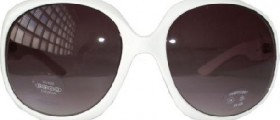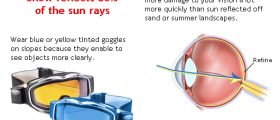In this article we are going to focus on the serious damage that the sun can cause to your eyes. Many people think that ultraviolet rays of the sun can only harm their skin, not knowing that they can damage their eyes profoundly at the same time.
Especially in the summertime, a lot of people expose their bodies and faces to the sun to get a good tan, and they do it without taking proper precautionary measures to protect their eyes from the severe impact of the sun rays.

Damage of the Sun
People should pay attention to how much time they spend in the sun, especially during summer months when the levels of ultraviolet radiation are higher than in winter. UV rays can harm your eyes really badly.
There are two types of UV rays: UVB that go through the front of the eye and UVA rays that go through the back of the eye. They both can do some serious damage to your eyes. Sun rays reflections from surfaces such as snow, water, sand, or pavements can really damage your eyes too.
Main Symptoms
There are many symptoms that indicate sun-damaged eyes. Even after 12 hours of exposure to the sun, symptoms may not be visible. Some of the symptoms include difficulty in looking at strong lights, painful tearing of the eyes, swelling of the eyes, excessive tearing and blinking, headaches, etc.
However, there are also some serious problems that people can experience after excessive exposure to the sun, and they include sunburn of the cornea, cancer of the eyelids, cancer of conjunctiva, cataracts, temporary loss of vision, etc.
Preventing Sun Damaged Eyes
To avoid sun damage to your eyes you need to take some preventive measures in advance. Sunglasses would be a very good choice. A few people know that UV rays can also damage their eyes even if it`s cloudy outside.
Everybody should wear sunglasses as they are very good for preventing your eyes from the UV rays of the sun. You should wear sunglasses that are able to filter UVB, as well as UVA rays, and the Eye Protection Factor for sunglasses shouldn't be below 10.
If you are wearing contact lenses you should buy ones that block around 80% of transmissible light.
Many people have experienced puffy and red eyes after swimming in the water as the reflected sun rays damaged their eyes. Protective goggles should be worn while swimming to reduce the possibility of damaging the eyes by the sun.
- The eye’s UVR absorption depends on the tissues considered and the person’s age and the wavelength received (UVB 280–315?nm or UVA 315–400?nm). Before the age of 8–10 years, 2–5% of UVR received by the eyes can reach the retina, while over the age of 25 years, this will only be 1–2%.
- In an experimental setup, the erythemally weighted UVR transmittance of three tinted (blue, brown, and green), commercially available, non-polarized plastic, category 3 (EN 1836: 2005) sunglass lenses was measured using as solar UVR source a 1000 W Xenon lamp (Solar LIGHT® Model LS-1000-4S-009 Solar Simulator, Glenside, Pennsylvania, USA) and a CIE erythemally weighted UVR dosimeter (Model X-2000 portable numeric dosimeter, Gigahertz-Optik GmbH, Puchheim, Germany) for the UVR transmittance.
- The dose measured without sunglass lenses was 51.1?J/m2. By comparison, 5?min outdoor occupational activity in Switzerland (latitude 45.83–47.69, altitude 500–600?m) at midday in summer leads to exposures of 247–495?J/m2. The three sunglass lenses tested showed doses below the threshold limit of
- Protected by different sunglasses styles, goggles blocked almost all UVR received at ocular and periorbital skin zones. Protected by middle-sized sunglasses, lateral periorbital (390.9?J/m2) and white lateral ocular (290.8?J/m2) skin zones received the highest total UVR doses during a cloudless summer day. The same skin zones received up to half UVR doses when large-sized sunglasses are worn (lateral periorbital: 180.6?J/m2 and white lateral ocular 201.1?J/m2).
- Daily cumulative doses received by periorbital and ocular skin zones protected middle- or large-sized sunglasses exceeded the 1.2 SED (120?J/m2 erythemally weighted) recommended threshold in cloudless summer exposure conditions, except for the tear duct and the white-medial skin zone (only for large-sized sunglasses).
A wide-brimmed cap or hat is also a very smart option for protecting one's eyes from direct exposure to the sun. Take care of your eyes as well as your skin when it comes to exposure to the sun. UV rays can harm your eyes without you even noticing it.

















Your thoughts on this
Loading...